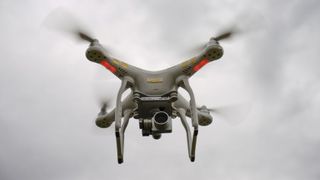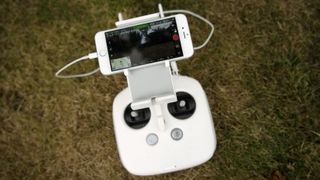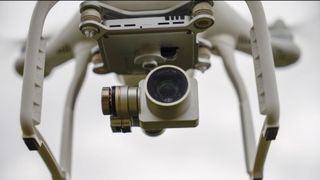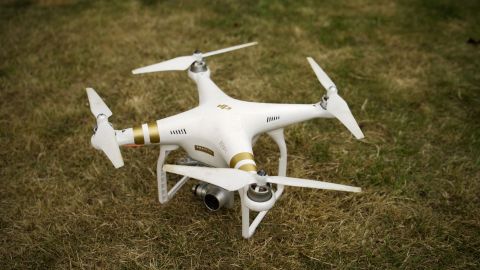Why you can trust TechRadar
In flight
If you've ever flown a quadcopter then you'll know it's not quite as easy as it looks, or at least that was the case before the Phantom 3.
Start-up is much the same as previous versions – wait for the four beeps and the variety of coded light sequences as it runs through its setup, then pull back on the two sticks to start the props and you're ready to fly.
In the past this is where a quick blast of power to launch would be needed to ensure that the quadcopter became airborne. With the Phantom 3, however, push and hold the launch button and auto launch is activated. Push up on the stick and the Phantom 3 goes up; release the stick and it stays where it is; push the stick hard to the left and it shoots off as expected; release the stick and it automatically brakes – the original would just keep on going.
The whole flight process has been updated, and the new flight controller at the centre of the Phantom 3 is incredible, even if you have never flown a quadcopter before you'll be able to get the basics of flight in minutes, whereas it took a good few hours of flight to skill the original.

The Phantom uses a series of sensors to stabilise the craft in flight, so alongside the GPS it also has two sensors on the underside. These work when GPS is lost or when you're flying indoors, and enable the Phantom to read and keep its location.
Out in the open the GPS and the new flight controller make controlling the Phantom easy, with the left stick enabling throttle and rotation and right stick tilt to make the quadcopter fly in the direction you want. Letting go of the sticks at any point holts the flight, and the Phantom will hang in the air until you're ready to take control again.
The live view stream is a great help when the craft is at a distance from you, as it enables you to gauge which direction the Phantom is travelling in – something which is more important than it sounds, as a small craft in the distance quickly becomes a dot, and it's almost impossible to tell which direction it's going.
The new flight controller, motor position and smart speed controller makes the Phantom 3 far more responsive and stable than previous generations.
The live view stream would also enable you to fly using a point of view perspective from the quadcopter, but in the UK this is outside of the CAA guidelines for flying these craft.
Controlling the camera
It's best to control the camera using the smartphone app and the controller unit in combination. Once a mobile device and handset are connected by the USB cable and the DJI Pilot app is loaded, you're ready to go. Then video recording can be started by just hitting the red button on the interface.
The camera can be used in two modes: still or video, selected through the app. If you do decide to fly without the aid of the app then the handset can be used on its own to control a limited set of the camera's functions. There are dedicated video record and photo shutter buttons on the top left and right of the handset.
Using the app in Photo or Video mode you have the option to shoot in Auto or Manual mode. The Auto Mode is the best one to get started with, and it handles the sensitivity (ISO) setting and shutter speed for you, but you're still able to adjust the exposure by means of the scroll wheel on the top right of the handset.
Manual mode is activated by hitting the manual settings icon in the bottom right of the app. Once activated you can then either touch to adjust the settings on the mobile device's screen, or use the right hand scroll wheel on the handset; clicking down on the wheel enables you to toggle between sensitivity (ISO) and shutter speed.

Sensitivity can be adjusted from ISO 100 for bright conditions down to ISO 3200 in Video mode or ISO 1600 in Photo mode for lower light. Shutter speed can vary from 1/30 to 1/8000 sec, enabling plenty of flexibility over exposure.
Hitting the camera options button on the screen switches back to auto mode. In auto mode the camera handles sensitivity and shutter speed, but you can still adjust the exposure compensation using the top left scroll wheel on the handset.
Before a flight it's always worth checking the camera settings with your mobile device, because settings such as exposure compensation are remembered, so you can easily find yourself shooting footage in auto mode that's underexposed or over exposed.
There are a good variety of shooting options and alongside the 4K video, with other resolution and frame rate combinations including 4K at 25fps(NTSC) or 24fps (PAL), 1080p Full HD at 50fps (NTSC) or 48fps (PAL) and 720p HD at 50fps (NTSC) or 48fps (PAL). This doesn't give as much scope as the GoPro Hero4, which enables 1080p at 120fps, but for a proprietary camera it's impressive.
A nice feature on the handset is the ability to tilt the camera up and down, which is controlled by the left hand scroll wheel on the handset. Panning is of course controlled by rotating the craft in flight.

The speed of the live view link is excellent, and during our tests proved to be essential for checking composition and exposure, as well as checking the direction the Phantom was headed when at a distance. The speed and reliability of the connection was consistent, and although there is a very slight delay the connection was never lost.
One feature that really stood out during our testing was the YouTube Live View streaming, and this is really going to appeal to many event photographers. Initial setup through YouTube and on an iPhone 6 took about 10 minutes, but was relatively straightforward. Once done it enabled a pretty good live stream at 720p HD over a 4G network.
A good connection is essential, and out in the countryside where 3G signal is weak, the results of streaming become pixelated or are lost completely, although this is to be expected due to the quality of the mobile network coverage.
Video quality, colour, tone and contrast are good, with colours looking bright and the level of contrast just giving the footage the punch and crispness it needs. Playing back footage on a 4K Sony TV, despite the lower frame rate, the Phantom 3's 4K video is perfectly smooth, and the overall quality is good.
There are exposure issues when the Phantom is headed towards bright areas, and the propellers do occasionally appear in footage, but these are minor quibbles.
Ali Jennings is the imaging lab manager for Future Publishing's Photography portfolio. Using Imatest Master and DxO Analyser he produces the image quality tests for all new cameras and lenses review in TechRadar's cameras channel. Ali has been shooting digital since the early nineties and joined Future's Photography portfolio back in 2003.

